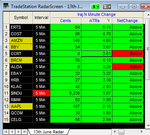I have attached a copy of what my radar screen looks like for the Iraj n minute change. It has 3 columns - cents, atr and netchange.Hi Charlton,
Thanks for replying.
I can't get the data compression column displayed in radar screen. Any suggestions on how would be greatly appreciated?
Kind regards
TMM
I think you want to insert the standard TS8 indicator called "Interval" as shown in the column to the left of the Iraj N minute.
I have also amended this indicator with the following 2 lines
If GETSYMBOLNAME = "$INDU" Then
SetPlotColor(1, Blue);
iF getsymbolname = "$INDU" then
Setplotbgcolor(1, white);
This highlights the interval or, for that matter any indicators that you can edit, for the $INDU. When you have an automated sort on ATR it makes it easier to spot which symbols are above or below the INDU. I also plan to create differential colours for those above and below the INDU row.
Hope this was what you were after
Charlton

